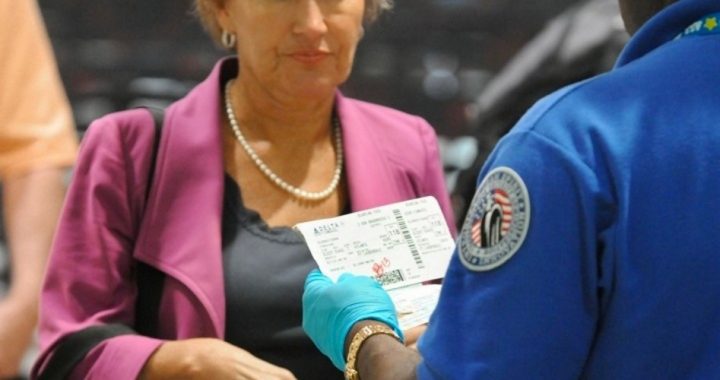
The amount spent by the Transportation Security Administration (TSA) since 2007 on a program to identify suspicious airplane passengers: $900 million.
The number of terrorists arrested as a result of this expenditure: zero.
That is the inescapable conclusion of a General Accountability Office (GAO) study released in November and subsequent congressional testimony by GAO’s director of homeland security and justice, Stephen M. Lord.
In 2003, the TSA began testing its Screening of Passengers by Observation Technique (SPOT) program, which, through the use of behavior detection officers (BDO), is “intended to identify high-risk passengers based on behavioral indicators that indicate mal-intent,” Lord told the House Transportation Security Subcommittee on November 14. Specifically, he explained,
Through the SPOT program, TSA’s BDOs are to identify passenger behaviors indicative of stress, fear, or deception and refer passengers meeting certain criteria for additional screening of their persons and carry-on baggage. During SPOT referral screening, if passengers exhibit additional behaviors, or if other events occur, such as the discovery of a suspected fraudulent document, BDOs are to refer these passengers to a law enforcement officer (LEO) for further investigation — known as a LEO referral — which could result in an arrest, among other outcomes.The TSA has spent approximately $900 million on SPOT since it was fully deployed in 2007, Lord said.
The latest GAO report on SPOT is a follow-up to a 2010 review in which the agency criticized the TSA for instituting the program without first determining if it had any scientific basis and without implementing any performance measurements to gauge its success.
The GAO reviewed “meta-analyses (studies that analyze other studies and synthesize their findings)” of over 400 behavior-detection studies from the last 60 years and concluded that “the ability of human observers to accurately identify deceptive behavior based on behavioral cues or indicators is the same as or slightly better than chance,” Lord said.
Thus, if the TSA had reviewed the relevant scientific literature on the subject prior to instituting SPOT, it would have determined that the program would be a waste of money. Of course, since the TSA isn’t spending its own cash, and since the creation of SPOT enabled the agency to increase its budget and add approximately 3,000 BDOs to Uncle Sam’s payroll — and, most likely, the government employees’ union’s ranks — as of fiscal year 2012, why on Earth would the TSA concern itself with the program’s efficacy?
The Department of Homeland Security (DHS) did perform a validation study of SPOT in 2011, but the GAO found that it “does not demonstrate effectiveness of the SPOT behavioral indicators because of methodological weaknesses,” Lord stated, including “the use of potentially unreliable data and issues related to one of the study’s outcome measures.”
Despite the GAO’s earlier criticisms and recommendations, the TSA still cannot tell whether SPOT is effective or not. As of June, the TSA had collected information for fewer than half the performance metrics the GAO had recommended in 2010, but it “was collecting little to none of the data required to assess the performance and security effectiveness of the SPOT program specifically,” said Lord. The agency did implement a new, more comprehensive data collection system this year. “However,” Lord observed, “according to the performance metrics plan, TSA will require at least an additional 3 years and additional resources before it can begin to report on the performance and security effectiveness of its behavior detection activities or the SPOT program.”
This leaves only the data on SPOT referrals, LEO referrals, and arrests by which to determine whether SPOT is working. Even using those limited metrics, it is clear that the program is a failure when it comes to detecting terrorists. “Of the approximately 61,000 SPOT referrals made during fiscal years 2011 and 2012 at the 49 airports we analyzed, approximately 8,700 (13.6 percent) resulted in a referral to LEO,” said Lord. “Of the SPOT referrals that resulted in a LEO referral, 365 (4 percent) resulted in an arrest.”
Furthermore, according to a footnote in Lord’s prepared testimony, “The SPOT database identifies six reasons for arrest, including (1) fraudulent documents, (2) illegal alien, (3) other, (4) outstanding warrants, (5) suspected drugs, and (6) undeclared currency.” The observant reader will note that terrorism is not even listed among the crimes for which anyone has been arrested under the program. In other words, the TSA has spent nearly a billion dollars on a program that has resulted in arrest only 0.59 percent of the time, and not once has it prevented a potential terrorist from boarding an airplane. (In fact, in its 2010 report the GAO found that 16 people who were later charged with terrorism-related activities managed to get by BDOs and onto airplanes — in some cases, more than once.)
CNSNews.com asked Lord if this was an accurate characterization of his remarks and the related footnote. He replied that it was “accurate for the arrests” but added that the “TSA believes that some of these referrals to law enforcement might be related to terrorism but has no supporting documentation or system to track the basis for these referrals.” That is, as with everything else related to SPOT, the TSA apparently expects people to take it on faith that the program has really caught terrorists.
The GAO, believing that SPOT is neither scientifically valid nor proven effective, recommended that the TSA “limit future funding for its behavior detection activities,” Lord told the congressional panel. “DHS,” he added, “did not concur with our recommendation.” Thus, despite its cost and ineffectiveness — not to mention, as The New American reported last year, the program’s potential chilling effect on free speech — SPOT is probably here to stay.



